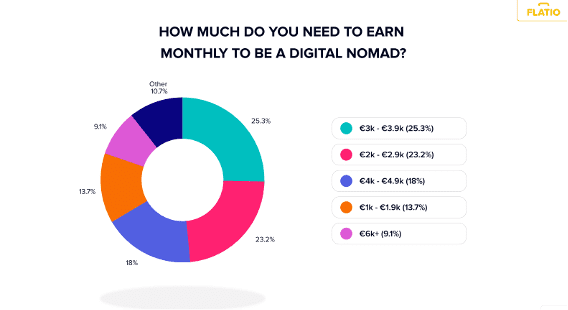|
|
Many myths circulate about how much money and how well you can live as a digital nomad. But is it realistic to imagine that you can earn US$50,000+ per year working only a couple of hours a day while spending only a few hundred a month living in a beach paradise and not paying any taxes? Probably not.
Let’s look at the reality of the financial aspects of being a digital nomad. We’ve scoured the internet to find data to answer the following questions. How much do digital nomads actually earn? Do digital nomads pay taxes and where? How affordable is the digital nomad lifestyle? How much money can you really make travel blogging?
Decoding Digital Nomad Earnings: Insights from the Flatio Survey
A recent survey conducted by Flatio has provided invaluable insight into how much digital nomads actually earn. So, what’s the verdict?
While the highest percentage of digital nomads was in the EUR 41-50,000 salary bracket, that was only 15.7%, and the survey respondents showed a wide income spread, with 8.8% earning less than EUR 20,000 a year, and only 8.8% earning more than EUR 100,000 per year.
You can see a full breakdown of the salary ranges in the graph below.

The digital nomads who reported these incomes had a wide variety of work backgrounds, but only 31.5% were full-time traditional employees, while the remainder were a mix of freelancers, self-employed individuals, and entrepreneurs. They also worked in a wide variety of fields, though the most common were IT and Technology, Media and Marketing, and Entrepreneurship.
Digital Nomad Taxes
The same Flatio survey asked digital nomads where they paid their taxes. The report showed that 66.1% continued to pay taxes in their home country while they were traveling, 19.4% had become tax residents in a new country, 9% paid no taxes, and around 5% had other arrangements.
These statistics help break down the myth that digital nomads can save money by not paying income tax. But that simply is not the case.
Understanding Tax Residency
International tax law says that you should pay income tax in your country of tax residency. While for most people their country of residence is also their tax residence, residency and tax residency are not the same. Tax residency is based on where you have a significant financial or physical presence and should therefore be contributing to the community via taxes.
As you move countries, your tax residence moves. As a general rule, you become a tax resident in a new country once you have been living there for 183 days continuously. But you can become a tax resident sooner than that if you established significant roots there.
However, you also continue to be a tax resident in your previous country until you have been out of the country for at least one full financial year or make a specific application to no longer be a tax resident. This means that you can find yourself a tax resident in more than one country.
Double taxation agreements exist between many countries to help determine where these types of people should pay taxes. Some visas, for example, some digital nomad visas, specifically state that holders will not become tax residents and should continue to pay taxes in their home country.
No Tax Residency Nomads
Based on this information, in theory, a digital nomad could find themselves a tax resident of nowhere, right? They have not lived in their home country for more than one year and they have not lived in another country for more than 183 days. But that is not accurate.
International tax law says that you are still a tax resident in the last country where you were until you have established a new tax residency. So, if the digital nomad in our scenario was last a tax resident in Germany but has been traveling around South America for more than a year without establishing a new residency, then they are still a tax resident in Germany.
So how do almost 10% of digital nomads get away with not paying taxes? While our digital nomad above may still be a tax resident of Germany, if they have not been in the country for more than a year, they probably aren’t being hunted down by the local tax department. Nevertheless, what they are doing is technically illegal.
Zero Tax Territorial Tax Nomads
Another approach that some digital nomads take is to establish tax residency in a country that only charges territorial tax. This is a tax system that only charges taxes on income earned within its territories. Therefore, in theory, as a digital nomad whose income is completely generated from overseas, you shouldn’t have to pay any taxes.
Examples of countries that charge territorial tax include Malaysia, Singapore, Thailand, the Philippines, Georgia, Panama, Nicaragua, Costa Rica, and many Caribbean countries.
However, this is also not as simple as it seems. While the client that you are working for may in international, some territorial countries still count the income as locally generated if the work was completed while you were physically in the country. Again, this is hard for local tax agents to control as they do not have visibility of the work, but not paying the tax can be illegal.
Nomad Taxes are Complex
One thing that it is fair to say is that digital nomad taxation is complex, but also that the vast majority of digital nomads need to be paying income tax. According to the Flatio survey, 18.5% of respondents reported tax issues as one of their major challenges.
And just as a note for our US readers, in the United States all citizens, regardless of where they are in the world, are considered tax residents and must lodge a tax return regardless of their circumstances. There are some international credit schemes in place to help avoid double taxation.
Affordable Cost of Living
One of the attractions of becoming a digital nomad is to be able to live somewhere in the world with a more affordable cost of living. This means that your money goes further and you can enjoy a better quality of life. But how much do you really need to live off as a digital nomad?
This clearly depends on where you choose to travel, and often the minimum income specified by digital nomad visas can be a good guide. But, clearly, digital nomads traveling to high-cost-of-living countries in Western Europe or wealthy Asian countries with new digital nomad visas, like Japan and South Korea, need more than nomads traveling around lower-cost-of-living countries in Southeast Asia or South America.
Nevertheless, Flatio survey respondents have suggested how much they think digital nomads need, with the majority suggesting between EUR 3,000-4,000 per month. See their responses in the table below.

Many new digital nomads underestimate the cost of living. This is for two key reasons. Firstly, while the general cost of living may be low, digital nomads often struggle to access the local housing market. This means that they tend to pay a premium for short term accommodation. This means that many digital nomads will spend 50% of their outgoings on rent.
In addition to this, for digital nomads who move frequently, air travel and visa applications can be an expensive overhead, as are necessities such as travel and international health insurance. These are all factors that many digital nomads don’t account for when estimating their cost-of-living expenses.
What About Travel Blogging?
Many digital nomads dream of turning their travel experience into an income stream through activities such as travel blogging, but how realistic is that?
TravelPayout recently surveyed 12 travel bloggers to see how much they make in a year through travel blogging. The verdict? It can be highly lucrative. The sites that they looked at had a monthly income ranging from less than US$600 a month to more than US$200,000.
However, they also found that most only started making money after being established for two years, and only started to generate strong income streams after 4-5 years. They found that the average monthly income for a blog that was less than one year old was only around US$5 per month. This rose to US$900 after the first year, US$1,200 for years 3-5, and to almost US$5,000 after year 5.
Digital Nomad Financial Myths Reconsidered
While the figures presented in this article may not align with the dream scenario presented at the very start, they show that digital nomadism is accessible regardless of your income level as long as you make the right decisions about where and how to travel. Plus, travel blogging can be lucrative if you are willing to put in the work and consider it a long-term investment. But you do have to pay taxes.












